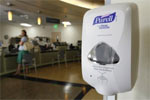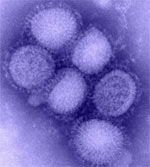 myCSUSM
myCSUSMH1N1 Campus Preparedness Article
Are We Ready for a Second Wave of the H1N1 Influenza aka "Swine Flu"?
by Dean Manship, Campus Emergency Manager
Fast Facts:
- All pandemics in recorded history have occurred in several waves of outbreaks; generally
three, with the second wave being the most severe. - Experts expect the second wave outbreak of the H1N1 Influenza to occur early this fall.
- The greatest risk is to pregnant women, children and young adults up to 25 years of age, and individuals with underlying medical conditions.
- A vaccine is currently in production and may be available as early as November.
Over the past several years the campus has been involved in planning and preparedness activities for a possible pandemic. The concern among epidemiologists and emergency managers is over the ease in which, and how often viruses are able to mutate or make slight changes to their genetic makeup resulting in a significant impact to humans. When a virus makes such a change, it may quickly spread through the human population which otherwise has little or no immunity to this new or "novel" virus. This is what is currently occurring with the H1N1 virus and although the first wave of the outbreak which occurred earlier this year was concerning, the worst may be yet to come.
"Those who cannot learn from history are doomed to repeat it."
George Santayana
Every pandemic in recorded history occurred in several waves of outbreaks, generally three with the second wave the most severe. Due to the time of year that this current H1N1 pandemic began and the effects the virus appears to have on the population, experts anticipate the H1N1 Flu to be very similar to the Asian Flu of 1957. In 1957 the first wave of the pandemic occurred in late spring and early summer with a series of small outbreaks in the United States. When schools reopened in the fall and in the midst of the regular flu season children quickly spread the disease and brought it home. The second wave outbreak occurred between September and the following March and was significantly more severe, having the greatest impact on pregnant women, children, and young adults.
So what should we do?
Educate! We need to educate the campus community that everyone must take responsibility for minimizing the spread of this disease.
What does that entail?
- Wash your hands regularly. The virus can live on surfaces such as door handles, countertops, telephones, handrails, etc. for up to 48 hours. Be conscious of the surfaces you touch and wash your hands with soap and water or use one of the many alcohol based hand sanitizer pumps that are located throughout campus. Consider carrying your own personal supply of hand sanitizer.
- Cover your cough. The disease is spread through bodily fluid particles that can be aerosoled up to 6 feet away when you sneeze or cough, contaminating surfaces and others around you. Cough or sneeze into a tissue or if a tissue is not available cough into your elbow sleeve. Do not cough or sneeze into your hand, however if you do happen to do so, immediately wash your hands.
- Make an effort to avoid touching your mouth, nose, and eyes with your hands, and if you do wash your hands before and after.
- Stay home when you are sick. You should stay home if you are experiencing a fever above 100ºF, headache, muscle ache, cough, runny or stuffy nose, sore throat, fatigue, and sometimes stomach symptoms such as nausea, vomiting or diarrhea. You may return to work/school after your fever has resolved on its own for at least 24 hours.
What is the campus doing to prepare?
Planning
- The campus has a Pandemic Influenza Plan so that appropriate and timely responses can be made based on various degrees in which the pandemic threatens the lives and safety of the campus community. This plan is currently being updated prior to the beginning of the fall semester to heighten our level of preparedness.
- The campus has a Pandemic Response Team comprised of key campus officials who monitor the status of the pandemic and are ready to take appropriate steps to better prepare and protect the campus. The Pandemic Response Team has been meeting regularly since the beginning of the first wave of H1N1 Flu earlier this year. The team is working closely with the County Health and Human Services Agency.
Education
- Information will be made available from the campus website with up-to-date information and guidance.
- Prior to the beginning of the fall semester an email will be sent to faculty and staff with current information and guidance.
- At the beginning of the fall semester an email will be sent to students with current information and guidance.
- Pandemic information and instructions on hand washing and covering your cough will be in the Emergency Management Video which is shown in classes during the first week of classes.
- Posters with instructions on hand washing and covering your cough will be posted in classrooms and other high traffic areas.
- Signage will be posted on the hand sanitizer stations to remind individuals to wash their hands and cover their coughs.
- Guidance will also be made available to managers so they may discuss practices and protocols with their staff.
Preparedness
- The campus has acquired and distributed hand sanitizer stations throughout campus and it is encouraged that the campus community use them as often as possible.
- The campus has also acquired an assortment of essential supplies that are likely to be in high demand or possibly unavailable during a second wave of outbreaks.
- Disinfectant wipes will be made available in the computer labs.
- Maintenance staff has been instructed to be more vigilant in cleaning and disinfecting high traffic areas on a regular basis.
- Student Health and Counseling Services is preparing to administer the seasonal flu shot as soon as it is available and the H1N1 flu vaccine later this fall. You may also receive these vaccines at your Primary Care Provider.
- The campus Pandemic Response Team personnel are in direct contact with the County Health and Human Services Agency, the San Diego Office of Emergency Services, and the Center for Disease Control and Prevention (CDC) for monitoring all updates on the situation status.
Aug 22, 2009 North County Times Article
Where can I get more information?









